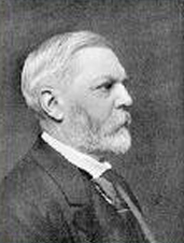
"Life's crucible hardens many a heart." — from An Illuminating Account of the John A. Roebling Sons Co.
The first child of renowned bridge designer John Augustus Roebling, Washington Augustus Roebling was born just about the time his father began experimenting with production of the wire rope that would make suspension bridges practical. It seems to have been an omen, as Washington Roebling, immediately upon graduation from Rensselaer Polytechnic Institute, went to work helping his father build the Allegheny Bridge, the first of several landmark bridges with which the family name would be associated.
Roebling's work with his father was interrupted by the Civil War in 1861. He enlisted in the Union's 6th New York Artillery and was assigned to engineering work, including the construction of a 1,200-foot suspension bridge across the Rappahannock River. Among his military duties was an assignment as an observer — each morning he ascended by balloon into the sky to gather intelligence on the whereabouts and activities of enemy forces. While performing this duty in June 1863, he was the first to spot Robert E. Lee's army approaching Gettysburg. Later, during the battle, he assisted on the ground by placing a cannon on Little Round Top just as Confederate General John Bell Hood began his famous and bloody attack. The cannon helped keep the vital strategic position in Union hands. When the war ended, Roebling had attained the rank of colonel. He also had made the acquaintance of the woman who would become his wife, Emily Warren, the sister of his commanding officer. He and Emily married in 1865. Roebling returned to his father's business after the war, assisting with the construction of the Covington-Cincinnati Bridge (see John A. Roebling Bridge) and others.
When the Brooklyn Bridge project was awarded to his father, Roebling traveled with his wife to Europe to research new developments in steel manufacturing and pneumatic caissons which were used in sinking piers below the surface of the water. But before construction began, his father died in 1869, leaving Washington Roebling in charge of the most ambitious suspension bridge project yet to be undertaken. It also left him and his brothers with the responsibility of managing his father's wire-rope business in Trenton, New Jersey. Roebling forged ahead with work on the bridge, beginning the important and dangerous task of sinking the pneumatic caisson for setting the foundations of the two immense towers at either end. Working in the caissons was difficult and dangerous — 20 men were killed during the construction, and many others suffered from the decompression sickness, also called "the bends," brought on by long hours in the caissons. As the construction progressed and the caissons sank deeper, the danger of this "caisson disease " grew. To buoy morale, Roebling insisted on staying in the caissons longer than the other workers. He soon began to suffer caisson disease himself. One day in 1872, he was brought back to the surface unconscious, and his life was saved only with great difficulty. Badly injured and fearing he wouldn't live to see the bridge completed, he spent four months compiling elaborate, detailed instructions for finishing the work. In the process, he impaired his own eyesight and became too weak to carry on long conversations with his assistants. He could only watch the construction progress from a window of his sickroom, and it was left to his wife to carry on the work, relaying his instructions to the workers and fending off skeptics who believed that the bridge couldn't be completed without his active participation. Fortunately, Emily Roebling was adequate to the task, and in 1883, he was able to watch from his window as she accompanied President Chester Arthur, who formally opened the bridge.
Although he spent the remainder of his life in great pain, Roebling recovered enough to resume management of the wire rope company. He also continued his favorite hobby, collecting minerals, and amassed a large collection that now resides at the Smithsonian Institution. In 1883, just as the Brooklyn Bridge was completed, Harper's Monthly described him as a "fit successor" for his father, "for at this time, when the grandest monument of engineering skill the world has ever seen is practically completed, certainly no other testimony is needed as to the great engineering ability and preeminent fitness of the younger Roebling to direct such a great undertaking."
Resources: McCullough, David, The Great Bridge: The Epic Story of the Building of the Brooklyn Bridge, Simon & Schuster, 1983.

